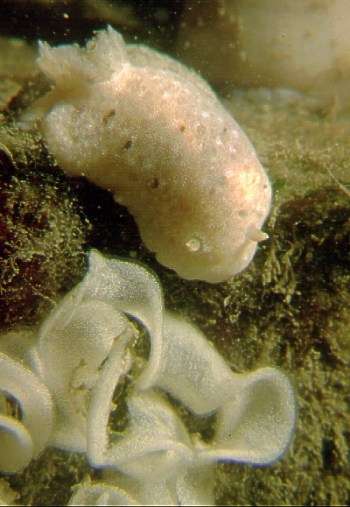
Jorunna tomentosa
(Cuvier, 1804)
Order: NUDIBRANCHIA
Suborder: DORIDINA
Family: Dorididae
DISTRIBUTION
North atlantic coast of Europe from Norway south to Portugal and Morocco. Perhaps the Mediterranean but the taxonomy of Mediterreanean Jorunna needs clarifying.
PHOTO
Plompe toren, de Oosterschelde, the Netherlands. PHOTO: Peter H. van Bragt
Like all species of Jorunna the mantle has a velvety appearance caused by the dense covering of caryophyllidia, which are tubercles with an array of protruding spicules (see photos of skin of Jorunna funebris and Jorunna pantherina).
The colour, mottled browns, creams and greys, combined with the spiculose mantle texture, ensure that this dorid is well camouflaged on the encrusting siliceous sponges on whicih it lives and feeds. These include Halichondria panicea and species of Haliclona. It grows to about 60mm long.
Reference:
• Thompson, T.E. & Brown, G.H. (1984) Biology of Opisthobranch Molluscs, Vol 2. Ray Society: London.
Rudman, W.B., 1999 (August 8) Jorunna tomentosa (Cuvier, 1804). [In] Sea Slug Forum. Australian Museum, Sydney. Available from http://www.seaslugforum.net/find/jorutome
Related messages
Jorunna from Tristan da Cunha
November 18, 2009
From: Sue Scott
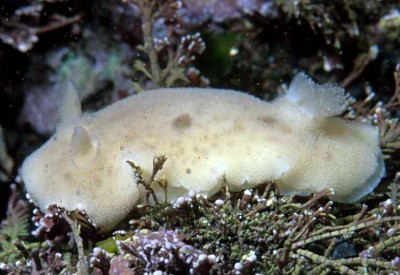
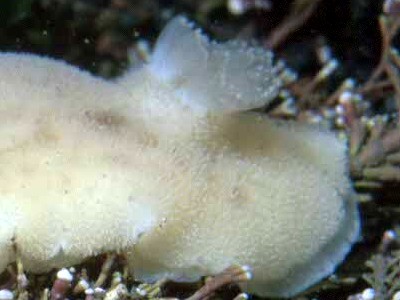
Note: For cross-reference I have posted 3 copies of this message. This copy deals with Jorunna sp. - Bill Rudman
Hello Bill,
I consult your very informative website from time to time to try & identify seaslugs. I'm a marine biologist normally resident in Scotland but I've been running a marine project on Tristan da Cunha for the past few years. Because the island is so isolated and geologically young it has a weird & wonderful fauna, mostly derived from waifs & strays rafted there on marine debris, both natural and manmade. Attached are 3 photos of seaslugs from Tristan, which I have tentatively identified as Tyrinna nobilis [message #22796], Doris/Anisodoris fontainei [message #22798] and Jorunna tomentosa. I'd be grateful for your expert opinion on these ids. Many of Tristan's animals also occur in Chile & Argentina, as is the case with the first two of these seaslugs. If the Jorunna is correct, it maybe came from the South African side.
Locality: Tristan da Cunha, Intertidal pools east of Harbour, British Overseas Territory, South Atlantic Ocean, 2004-2007 (dates available), Extremely exposed rocky coasts. 37 03' 50.94"S, 12 18' 43.64"W. (position derived from Google Earth; note decimal seconds) Photographer: Sue Scott
Regards,
Sue
suescott153@btinternet.com
Scott, S., 2009 (Nov 18) Jorunna from Tristan da Cunha. [Message in] Sea Slug Forum. Australian Museum, Sydney. Available from http://www.seaslugforum.net/find/22799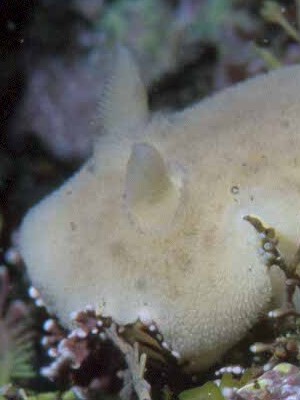
Dear Sue,
Certainly this looks like a species of Jorunna but without looking at its anatomy it might be difficult to identify it to species. It certainly could be J. tomentosa which is found from nthn Europe south to South Africa, but it also has similarities to Jorunna spazzola (Marcus, 1976) which was described from Brazil but has since been reported as far north as the Caribbean and across to the Mediterranean (Camacho-Garcia & Gosliner, 2008).
I am afraid the genus Jorunna is probably not the best for bio-geographical studies as I suspect it will be a while before we have the species sorted out. Unless some one offers a better idea, I think I will leave your animal as a tentative J. tomentosa.
- Camacho-Garcia, Y. E., & Gosliner, T.M., 2008. Systematic revision of Jorunna Bergh, 1876 (Nudibranchia: Discodorididae) with a morphological phylogenetic analysis. Journal of Molluscan Studies 74(2):143-181.
Best wishes,
Bill Rudman
Jorunna tomentosa spawning
September 9, 2008
From: Joao Pedro Silva
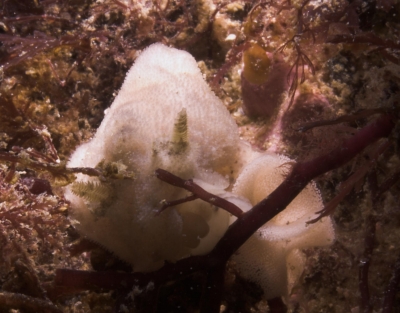
Dear Bill,
Here is a large Jorunna tomentosa spawning. At first I could only notice the eggs but a closer inspection revealed there something else in there. The "fur" on the mantle really makes it look like part of the egg mass.
Locality: Peniche, 10 metres, Portugal, North Atlantic, 02 September 2007, Rocky bottom. Length: 3 cm. Photographer: Joao Pedro Tojal Loia Soares Silva.
Cheers,
Joao Pedro
jpsilva@uwphotographer.net

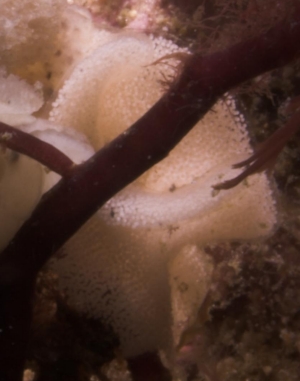
Thanks Joao Pedro,
Bill Rudman
Rudman, W.B., 2008 (Sep 9). Comment on Jorunna tomentosa spawning by Joao Pedro Silva. [Message in] Sea Slug Forum. Australian Museum, Sydney. Available from http://www.seaslugforum.net/find/20640Jorunna tomentosa from Sardinia?
November 29, 2006
From: Alberto Piras
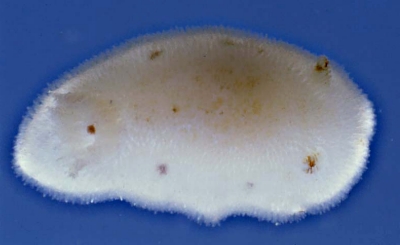
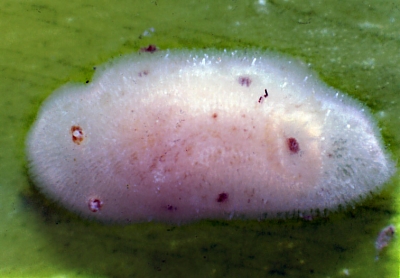
Dear Bill,
Here are two photos of an opisthobranch mollusc from Sardegna, that I have determined is Jorunna tomentosa, I would be pleased if you could confirm this classification
Locality: Sardinia, Italy, 2 m. Mediterranean Sea, July 1996, on algae. Length: 25 mm . Photographer: Alberto Piras
Best regards
Alberto Piras
albert.pir@tiscali.it
Piras, A., 2006 (Nov 29) Jorunna tomentosa from Sardinia?. [Message in] Sea Slug Forum. Australian Museum, Sydney. Available from http://www.seaslugforum.net/find/17075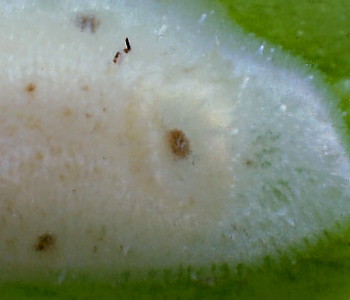
Dear Alberto,
This animal certainly fits within the range we currently accept as Jorunna tomentosa. I suspect that there could be some undescribed or unrecognised species of Jorunna in the NE Atlantic and Mediterranean Sea. In 1976 Eveline Marcus described Jorunna lemchei from specimens sent to her from the west coast of Ireland but whether these animals are truly a separate species has never been confirmed.
- Marcus, E. (1976) On Kentrodoris and Jorunna (Gastropoda Opisthobranchia). Boletim de Zoologia, Universidade de Sao Paulo 1: 11-68.
Best wishes,
Bernard Picton
Jorunna tomentosa from Plymouth, UK
August 11, 2006
From: Judith Oakley
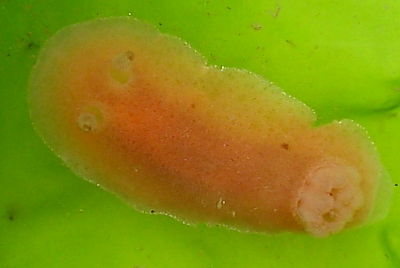
Dear Bill
Have been busy doing some marina surveys recently and came across a couple more sea slugs. Thought this must be Jorunna tomentosa, although the brown spots weren't very obvious. It was on Ulva lactuca.
Locality: Mayflower marina, Plymouth, UK, 07 August 2006, Marina pontoon on Ulva lactuca. Length: 4cm. Photographer: Judith Oakley.
regards
Judith
jomoakley@btinternet.com
Oakley, J.A., 2006 (Aug 11) Jorunna tomentosa from Plymouth, UK. [Message in] Sea Slug Forum. Australian Museum, Sydney. Available from http://www.seaslugforum.net/find/17385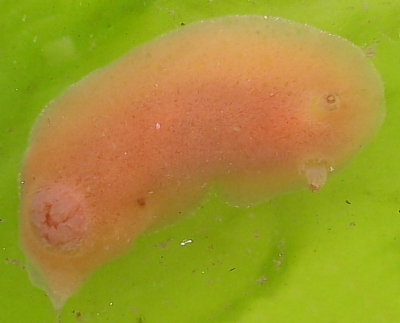
Dear Judith,
Yes this is Jorunna tomentosa. As in most species of the genus, the darker speckling on the mantle is sometimes more obvious than others, even in the same animal
Best wishes,
Bill Rudman
Jorunna tomentosa from the Adriatic
April 21, 2006
From: Tancredi D'Onofrio
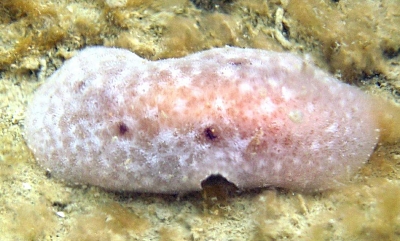
Hello,
Is this Jorunna tomentosa?
About 4 cm, with dark spots (4-6) on the sides of the mantle.
Locality: Gulf of Trieste, 5 m., Italy, Northern Adriatic, Jan.-Feb. 2005. Length: 4 cm. Photographer: Tancredi D'Onofrio.
Thank you
Tancredi
donofrio2t@libero.it
D'Onofrio, T., 2006 (Apr 21) Jorunna tomentosa from the Adriatic. [Message in] Sea Slug Forum. Australian Museum, Sydney. Available from http://www.seaslugforum.net/find/16325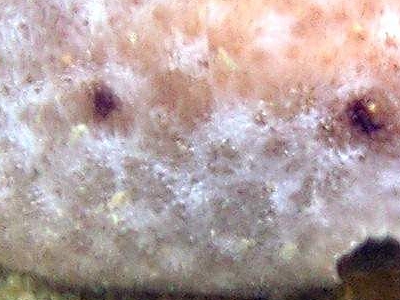
Dear Tancredi,
Yes I think this is Jorunna tomentosa, but I would appreciate some comments from local experts. I have included a close-up of the mantle, just in case.
Best wishes,
Bill Rudman
Re: Is this a Jorunna species?
October 3, 2005
From: Mehmet Baki Yokes
Dear Bill and Aziz,
Concerning message #14848:
In summer, Jorunna tomentosa is commonly observed around the coasts of Istanbul (Sea of Marmara) on rocky surface, below 20 m of depth. The individuals seen on the photo looks very much alike with the ones I have examined, and I also think that they are Jorunna tomentosa.
Best wishes
Baki Yokes
bakiyokes@turk.net
Yokes, M.B., 2005 (Oct 3) Re: Is this a Jorunna species?. [Message in] Sea Slug Forum. Australian Museum, Sydney. Available from http://www.seaslugforum.net/find/14904Thanks Baki,
Bill Rudman
Dorid from Slovenia [3]
October 1, 2005
From: Tom Turk
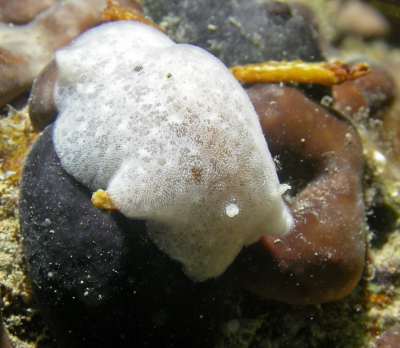
Dear Bill,
Here is another photo taken in front of Marine Biological Station in Piran, Slovenia. It is probably Jorunna tomentosa crawling on a sponge Chondrilla nucula.
Locality: Piran, Slovenia, Adriatic Sea. Spring 2005. muddy, some rocks and algae. Photographer: Tihomir Makovec
Best regards,
Tom Turk
tom.turk@bf.uni-lj.si
Turk, T., 2005 (Oct 1) Dorid from Slovenia [3]. [Message in] Sea Slug Forum. Australian Museum, Sydney. Available from http://www.seaslugforum.net/find/14888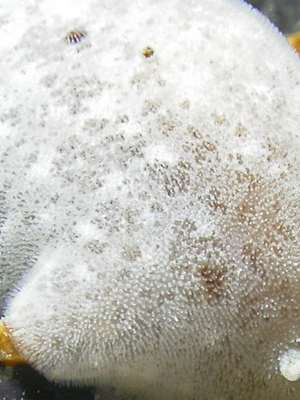
Dear Tom,
I also think this is Jorunna tomentosa. The close-up alongside shows the spiculate tubercles [caryophyllidia] which give the mantle its 'furry' appearance, and hence the name 'tomentosa', from hairy in Latin.
Best wishes,
Bill Rudman
Is this a Jorunna species?
September 29, 2005
From: Aziz Saltik
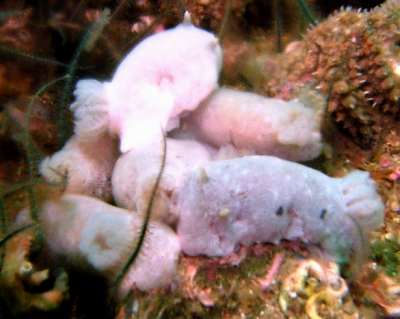
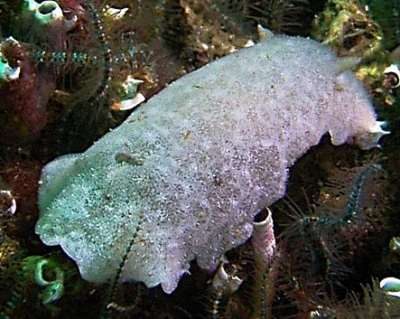
Good Day,
These nudibranchs were photographed by me in my hometown Istanbul, Turkey, on Prince's Islands.
Locality: Prince's Islands, Istanbul, Turkey, Sea of Marmara. Depth: 20 meters. Length: 4-5 cm. 17 July 2005. Cold water, poor visibility, rocky bottom. Photographer: Aziz T. Saltik
It was cold and with very poor visibility. I think they are a Jorunna species but have doubts, will be grateful if you could help me in identifying them.
Best Regards,
Aziz T. Saltik.
asaltik@enka.com
Saltik, A.T., 2005 (Sep 29) Is this a Jorunna species?. [Message in] Sea Slug Forum. Australian Museum, Sydney. Available from http://www.seaslugforum.net/find/14848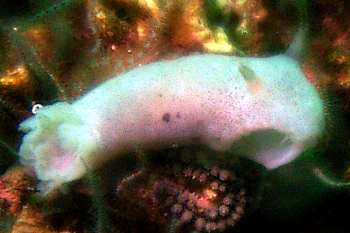
Dear Aziz,
Certainly the shape of the animals in the upper photos, where they are clustered together and the shape of their gills, and their 'furry' mantle, clearly visible in the second photo, suggest a species of Jorunna, probably Jorunna tomentosa. However there are other similar looking dorid species in the Mediterranean so I hope someone familiar with the fauna can confirm my identification or suggest a better one,
Best wishes,
Bill Rudman
Jorunna tomentosa from Portugal
March 2, 2004
From: Joao Pedro Silva
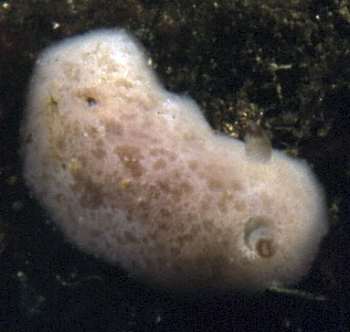
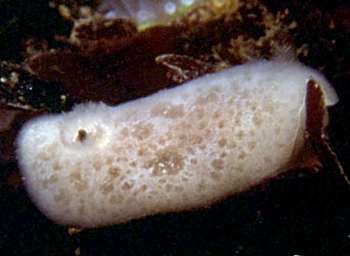
Dear Bill,
I found this nudibranch last weekend in Baleal, Portugal. At first it looked like Cadlina pellucida but the rhinophores were not so dark. Also there were so markings on the body which didn't fit Cadlina pelucida's description. It was aprox. 1cm long, maybe less.
At this moment I have absolutely no idea of what this may be. Could it be some other species of the Cadlina genus?
All the best,
Joao Pedro
http://uwphoto.no.sapo.pt
jpsilva@uwphotographer.net
Silva, J.P., 2004 (Mar 2) Jorunna tomentosa from Portugal. [Message in] Sea Slug Forum. Australian Museum, Sydney. Available from http://www.seaslugforum.net/find/12350Dear Joao Pedro,
Form the 'furry' nature of the mantle this is almost certainly a species of Rostanga or Jorunna. Form its colour I am pretty sure itis the common Jorunna tomentosa.
Best wishes
Bill Rudman
Re: Jorunna tomentosa from French Brittany
June 11, 2003
From: Peter H. van Bragt
Hello Marina and Bill,
This is for sure a J. tomentosa. The typical furry mantle texture and the few dark spots on the site are indicative for this species.
Best regards
Peter
vanbragt.phjm@hsbrabant.nl
van Bragt, P.H., 2003 (Jun 11) Re: Jorunna tomentosa from French Brittany. [Message in] Sea Slug Forum. Australian Museum, Sydney. Available from http://www.seaslugforum.net/find/10176Thanks Peter,
Bill Rudman
Re: Jorunna tomentosa from French Brittany
June 6, 2003
From: Alma Sanchez
Dear Marina and Dr. Rudman,
Definitely, this animal is Jorunna tomentosa.
Best wishes,
Alma
almasanchez83@hotmail.com
Thanks Alma,
Bill Rudman
Jorunna tomentosa from French Brittany
June 5, 2003
From: Marina Poddubetskaia
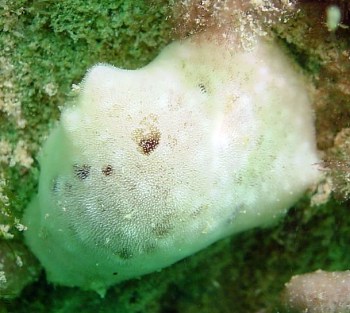
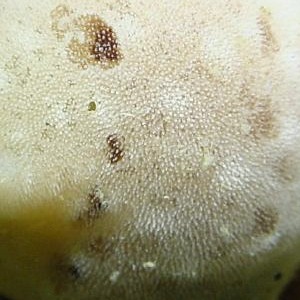
Dear Bill,
I found this dorid during my diving week-end in Mont Saint-Michel Bay. Could you confirm it is Jorunna tomentosa, please? Sorry for these bad photos, I was able to make better.
Date: April 19, 2003
Location: Saint-Malo, France, Atlantic coast
Site: Bizeux
Depth: 7m
Size: 35mm
Temperature: 12°C
Photos: Marina Poddubetskaia - Nembro website
Best wishes,
Marina.
nembro@nembro.info
Poddubetskaia, M., 2003 (Jun 5) Jorunna tomentosa from French Brittany. [Message in] Sea Slug Forum. Australian Museum, Sydney. Available from http://www.seaslugforum.net/find/9769Dear Marina,
I would agree with your indentification, but as I tend to call all these 'furry' animals from Europe Jorunna tomentosa I think I will wait for confirmation from someone with firsthand experience of the Atlantic fauna
Best wishes,
Bill Rudman
Re: Unidentified dorid from Spain
November 28, 2002
From: Peter H. van Bragt
Hello Bill,
Alma Sanchez's educated guess to call this Dorid seaslug Jorunna tomentosa seems to me quite realistic. Obviously we see insufficient details of the animal on the picture to be 100% sure. The brown markings on the side and the texture of the mantle seem to indicate that this is correct. Also this animal was found well within it known West-European distribution range: Faeroes to the Mediterranean (Picton, 1994)
Peter H. van Bragt
vanbragt.phjm@hsbrabant.nl
Thanks Peter,
Bill Rudman
Re: Unidentified dorid from Spain
November 23, 2002
From: Alma Sanchez
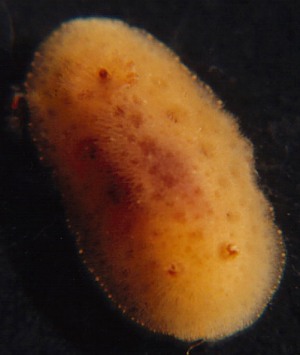
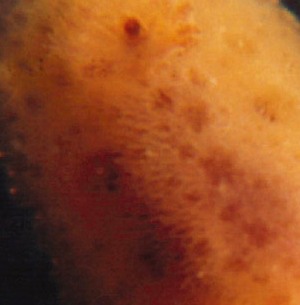
Dear Dr. Rudman and Miquel,
I think Miquel's animal is Jorunna tomentosa. Here is one photo of a juvenile specimen of this species collected in the Strait of Gibraltar (Southern Spain) showing several aspects of its external anatomy and coloration such as a mantle covered with caryophyllidia and brown spots
Best wishes,
Alma
almasanchez83@hotmail.com
Sanchez, A., 2002 (Nov 23) Re: Unidentified dorid from Spain. [Message in] Sea Slug Forum. Australian Museum, Sydney. Available from http://www.seaslugforum.net/find/8472Thanks Alma,
I tend to agree with you. Photos which don't show any esential features are very difficult to be sure about, although to local experts they are often quite obvious.
Best wishes,
Bill Rudman
Unidentified dorid from Spain
November 23, 2002
From: Constantine Mifsud
Dear Bill,
I think Miquel's mystery is a Lamellaria perspicua [Velutinidae] not an Opisthobranch
Constantine Mifsud
kejdon@orbit.net.mt
Thanks Constantine,
It's hard to be sure when you can't see any characteristic features. I thought I could see the gill pocket in the lower part of the photo. You could be right, but I tend to agree with Alma's suggestion that it is Jorunna tomentosa.
Best wishes,
Bill Rudman
Unidentified dorid from Spain
November 21, 2002
From: Miquel Pontes
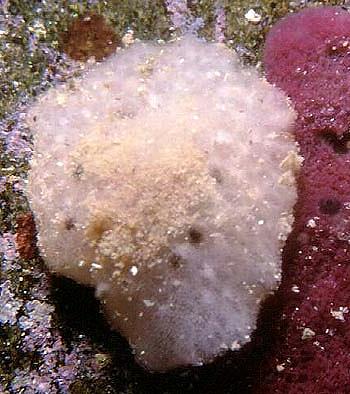
Dear Bill,
We found an unidentified dorid(?) attached below a rock in less than 1 meter of water at Cadaqués, Costa Brava, Spain [Mediterranean coast]. We would be grateful if you can supply clues to identify it.
Picture by Albert Ollé.
Miquel Pontes
mpontes@marenostrum.org
Pontes, M., 2002 (Nov 21) Unidentified dorid from Spain. [Message in] Sea Slug Forum. Australian Museum, Sydney. Available from http://www.seaslugforum.net/find/8380Dear Miquel,
I'm afraid I can't help. Hopefully one of the many opisthobranch workers in that part of the world can give us an idea
Best wishes,
Bill Rudman
Unknown dorid from Helgoland, Germany
June 22, 2002
From: Philipp Schubert
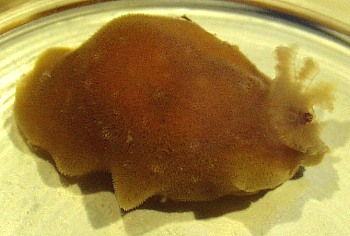
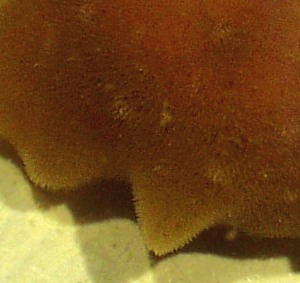
Hi, Dr. Rudman.
I´m a German student from Helgoland, [North Sea, Germany] gathering Nudibranchs for my thesis. Yesterday I found a species, which I can´t define for sure using two books available to me (Synopses: Benthic Opisthobranchs by Thompson and Marine Fauna by Hayward and Ryland). Is it Aldisa zetlandica perhaps??
We found it diving in 5m depth on a harbour wall on no specific substratum, but sponges were present, also lot of Clavelina ascidians. The mantle looks smooth, but it bears thousands of very small papillae. The gills are retractable and the rhinophores are nearly invisible, the mantle is very ample, the anus is pumping weirdly...
Please help, I´m nearly desperate...;-)
Philipp Schubert
pschubert@awi-bremerhaven.de
Schubert, P., 2002 (Jun 22) Unknown dorid from Helgoland, Germany. [Message in] Sea Slug Forum. Australian Museum, Sydney. Available from http://www.seaslugforum.net/find/7327Dear Philipp,
Aldisa zetlandica has large conical tubercles on its back. The 'furry' texture on the back of this animal suggests a species of Rostanga or Jorunna. The only likely species in your part of the world would be Jorunna tomentosa, which ranges in colour from a pale off-white to a dirty brown, usually with scattered darker spots or patches. A colour variety, which was described as a distinct species, Jorunna lemchei Marcus, 1976, [but usually considered as synonym of J. tomentosa], looks much like your animal in having scattered pale spots. There are good colour illustrations of 'Jorunna lemchei' in Just & Lemche (1985).
I could of course be wrong, but if so, I am sure one of our European colleagues will let us know.
• Just, H. & Edmunds, M. North Atlantic Nudibranchs (Mollusca) seen by Henning Lemche. Ophelia: Supplement 2. Ophelia Publications: Helsingor. 170pp.
Best wishes,
Bill Rudman
Jorunna tomentosa from southern France
January 23, 2002
From: Jean-Pierre Bielecki
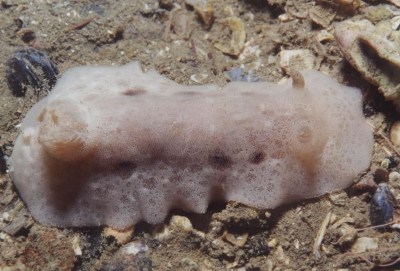
Dear Bill,
Here is another species looking like an Archidoris pseudoargus but I am not sure. Thanks again for your help.
Date: March, 12th 2001
Dive place: Sète (Mediterranean coast of France)
Dive site: Etang de Thau
Depth: 0.5m
Size: 5cm
Best regards
Jean-Pierre Bielecki
bielecki.jeanpierre@free.fr
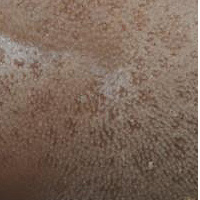
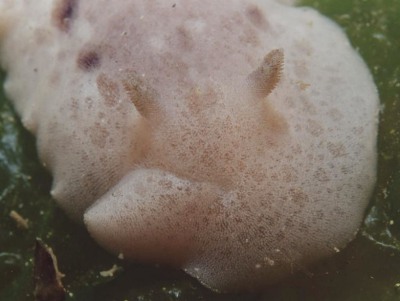
Dear Jean-Pierre,
If you look at the 'furry' nature of the skin this is almost certainly Jorunna tomentosa.
Best wishes,
Bill Rudman
Jorunna tomentosa from the Netherlands
August 11, 1999
From: Peter H. van Bragt

Dear Bill,
Here is a photo of Jorunna tomentosa to add to the Netherlands' List.
Location: Plompe Toren, de Oosterschelde, the Netherlands
Met vriendelijke groeten
(With best regards)
Peter H. van Bragt
Peter.vanBragt@ftn.hsbrabant.nl
van Bragt, P.H., 1999 (Aug 11) Jorunna tomentosa from the Netherlands. [Message in] Sea Slug Forum. Australian Museum, Sydney. Available from http://www.seaslugforum.net/find/1168Thanks Peter.
Bill Rudman.
